Boletus L.
Recent molecular studies have shown that Boletus in its current circumscription is likely an artificial grouping and it is possible that it will be split at some point into smaller genera. Note that Boletus impolitus and Boletus depilatus for practical reasons are retained here, although there is strong evidence that they are closely related to Xerocomus subtomentosus and its allies.
Fruitbody large to medium sized, boletoid, without veil and ring. Stipe solid, with surface usually covered with granules or network. Flesh variously coloured, changing or not when exposed to air. Tubes easily separable from each other, not tearing apart. Pores usually small and rounded.
Boletus impolitus Fr.
Description
Pileus up to 10 cm, at first hemispherical, then convex to flat-convex, dry, usually smooth or finely dusted, greyish, greysh ochraceous, pale ochraceous or pale brown, unchanging when bruised. Stipe cylindrical, club-shaped or swollen, cream or pale yellow to yellow, below the tubes often with reddish or rusty band, sometimes yellow orange to red in the base, covered with scattered concolorous with the background or darker granules, unchanging when bruised. Flesh in young fruitbodies pale lemon yellow, later whitish, but pale yellow below the stipe cuticle, unchanging when ecxposed to air. Tubes pale yellow to yellow with olivaceous tint, unchanging. Pores concolorous with the tubes, unchanging when bruised. Smell in young fruitbodies mostly not distinctive, later of iodine. Taste not distinctive. Spores 10–16 × 4–6 μm, ratio 22–34. Pileipellis (the cap cuticle) a trichodermium, composed of hyphae of long cylindrical not encrusted cells. Chemical reactions: hyphae of the flesh in the stipe base inamyloid with Melzer’s reagent.
Habitat. Broadleaf forests, mycorrhizal with oaks (Quercus), probably also with other deciduous trees.
Distribution. Throughout Europe, but apparently more common in south, absent in the far north.
Similarity. Similar and might be confused with Boletus depilatus. The later is recognized in the field by its wrinkled or hammered cap surface and its mycorrhiza with hornbeam or hop-hornbeam. Examination of the cap cuticle is always required to confirm the determination.
Photographs

Fruitbodies of Boletus impolitus. Note the unchanging flesh. (photo M. Mikšík)
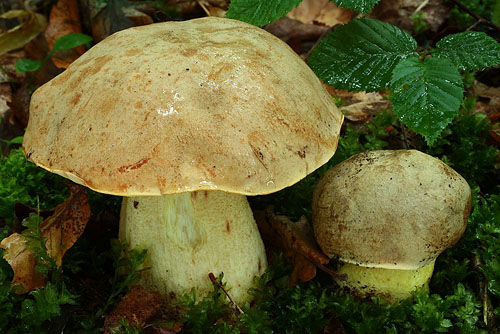
Typical fruitbodies of Boletus impolitus. (photo M. Mikšík)
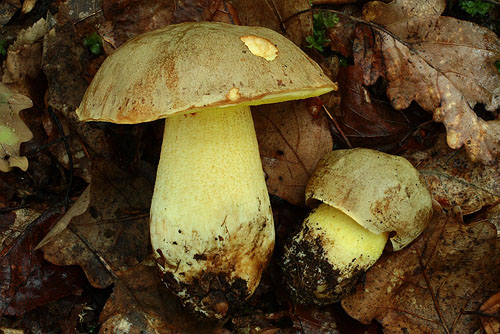
Fruitbodies of Boletus impolitus. (photo M. Mikšík)
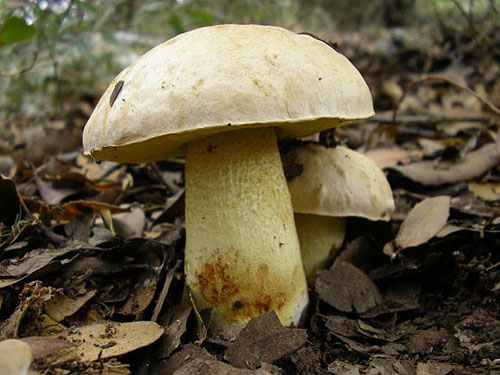
Typical pale fruitbodies of Boletus impolitus. Note the stipe ornamentation. (photo Z. Shafranov)
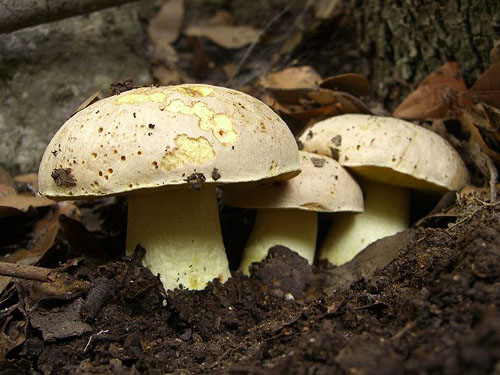
Fruitbodies of Boletus impolitus. (photo R. Kuznetsov)
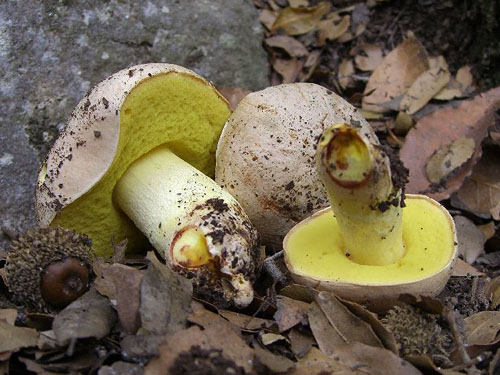
Fruitbodies of Boletus impolitus. Note the yellow unchanging pores. (photo R. Kuznetsov)
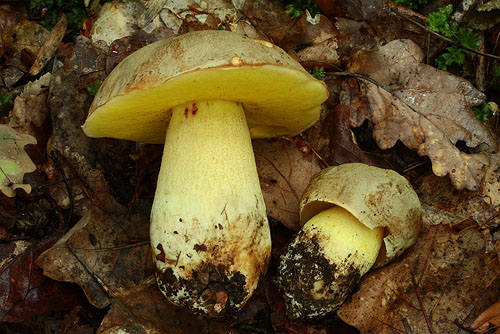
Fruitbodies of Boletus impolitus. (photo M. Mikšík)

Fully developed fruitbodies of Boletus impolitus. (photo B. Assyov)
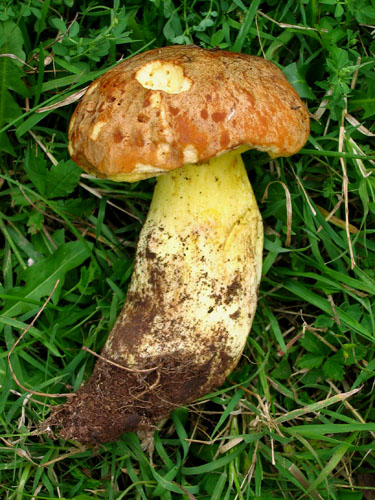
Fully developed fruitbody of Boletus impolitus. (photo B. Assyov)
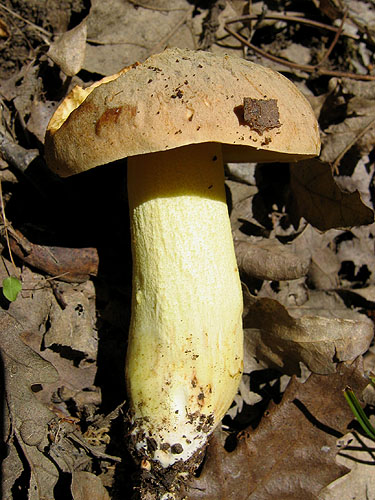
Fully developed fruitbodies of Boletus impolitus. (photo B. Assyov)
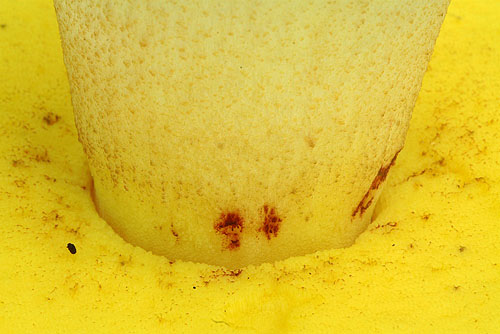
Stipe surface of Boletus impolitus. Note the granulations. (photo M. Mikšík)
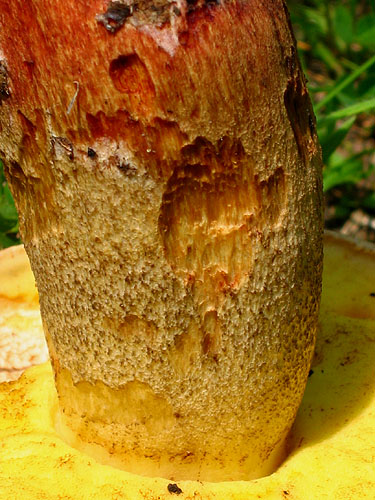
Boletus impolitus - stipe surface. Note the granulations and the reddish colour which is generally quite unusual. (photo B. Assyov)
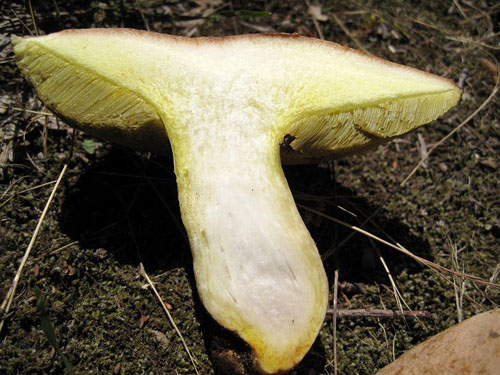
Flesh of Boletus impolitus. Note the characteristic yellow colouration at the stipe base. (photo A. Grozdanov)
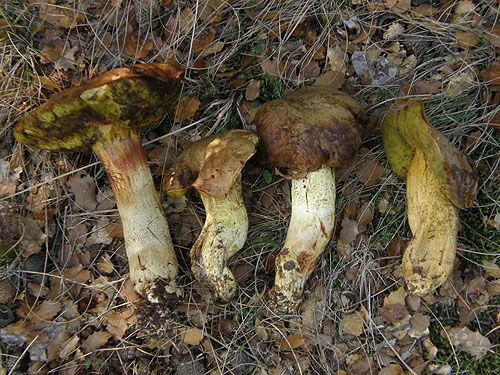
Old basidiomata of Boletus impolitus with dark caps and discoloured stipes as often seen in extremely dry habitats. (photo B. Assyov)
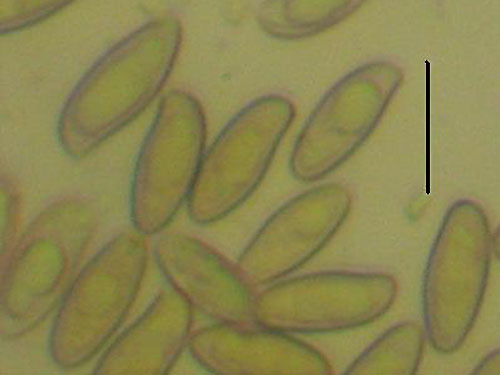
Basidiospores of Boletus impolitus. (photo B. Assyov)
Important literature
Alessio, C.L. 1985. Boletus Dill. ex L. (sensu lato). – In: Fungi Europaei. Vol. 2. Pp. 1–705. Libreria editrice Biella Giovanna, Saronno.
Breitenbach J. & Kränzlin F. 1991. Pilze der Schweiz. Bd. 3(1). Röhrlinge und Blätterpilze. Verlag Mykologia, Luzern.
Engel, H., Krieglsteiner, G., Dermek, A. & Watling, R. 1983. Dickröhrlinge. Die Gattung Boletus in Europa. Verlag Heinz Engel, Weidhausen b. Coburg.
Estadès, A. & Lannoy, G. 2004. Les bolets européens. – Bulletin Mycologique et Botanique Dauphiné-Savoie 44(3): 3–79.
Galli, R. 1998. I Boleti. Atlante pratico-monographico per la determinazione dei boleti. Edinatura, Milano.
Hansen, L. & Knudsen, H. 1992. Nordic Macromycetes. Vol. 2. Polyporales, Boletales, Agaricales, Russulales. Nordsvamp, Copenhagen.
Knudsen, H. & Vesterholt, J. [eds.]. 2008. Funga Nordica. Nordsvamp, Kopenhagen.
Ladurner, H. & Simonini, G. 2003. Xerocomus s.l. – In: Fungi Europaei. Vol. 8. Pp. 1–527. Edizioni Candusso, Alassio.
Lannoy, G. & Estadès, A. 2001. Les Bolets. Flore mycologique d’Europe. Documents Mycologiques Mémoire Hors série no. 6. Pp. 1–163. Association d’Écologie et de Mycologie, Lille.
Muñoz, J.A. 2005. Boletus s. l. – In: Fungi Europaei. Vol. 1. Pp. 1–951. Edizioni Candusso, Alassio.
Pilát, A. & Dermek, A. 1974. Hríbovité huby. Československé hríbovité a sliziakovité huby (Boletaceae – Gomphidiaceae). Veda, Bratislava.
Singer, R. 1967. Die Röhrlinge. II. Die Boletoideae und Strobilomycetaceae. – In: Die Pilze Mitteleuropas. Vol. 6. Pp. 1–151. Julius Klinkhardt Verlag, Bad Heilbrunn.
Šutara, J., Mikšík, M. & Janda, V. 2009. Hřibovité houby. Čeled’ Boletaceae a rody Gyrodon, Gyroporus, Boletinus a Suillus. Academia, Praha.
Watling, R. 1970. Boletaceae, Gomphidiaceae, Paxillaceae. – In: Henderson, D.M., Orton, P.D. & Watling, R. [eds]. British fungus flora. Agarics and Boleti. Vol. 1. Royal Botanic Garden, Edinburgh.
Watling, R. & Hills, A.E. 2005. Boletes and their allies (revised and enlarged edition). – In: Henderson, D.M., Orton, P.D. & Watling, R. [eds]. British Fungus Flora. Agarics and boleti. Vol. 1. Royal Botanic Garden, Edinburgh.